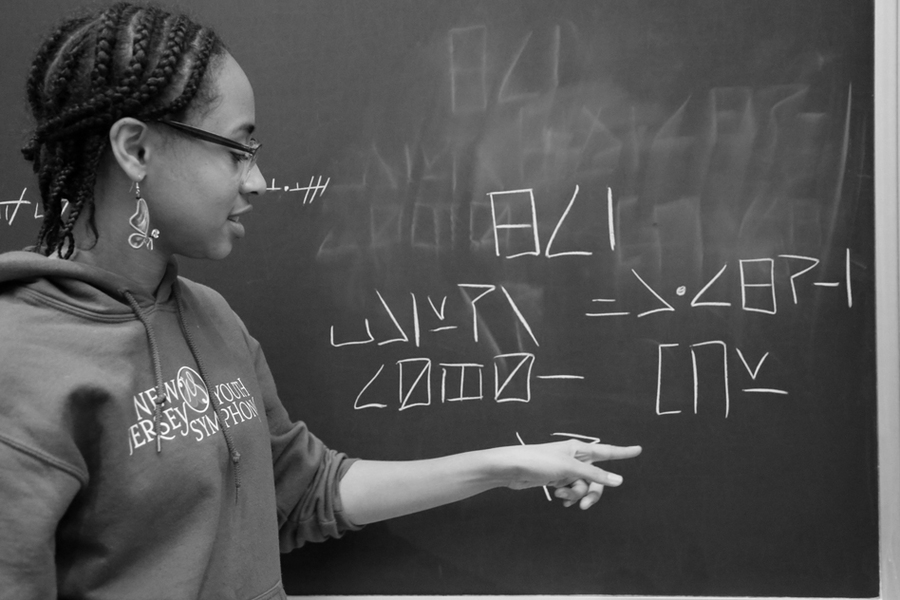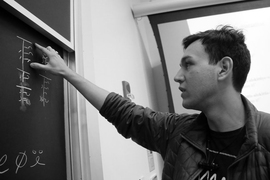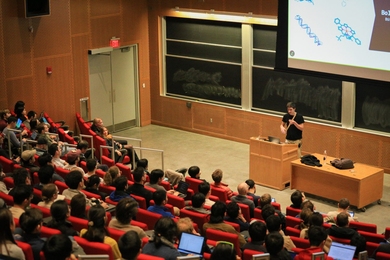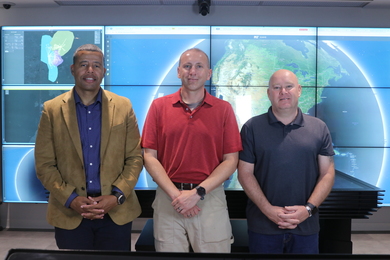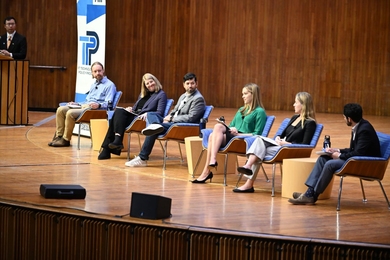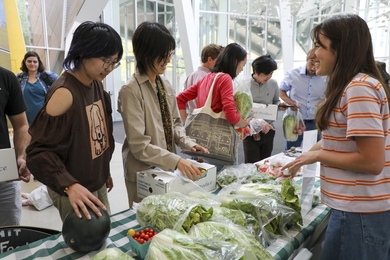The following podcast and transcript are part of a feature on MIT's course 24.917 (ConLangs: How to Construct a Language). Read the accompanying article.
FEMALE VOICE: All human beings are born free and equal in dignity and rights. We are endowed with reason and conscience to act. [Crosstalk] [Phrases in foreign languages]
HOST: Language. We as human beings are surrounded by language all the time, whether we're reading, writing or speaking it. Language is embedded in our everyday. But what is language? What makes language a language, and not just a group of words, gestures, or sounds? By definition, language is the method of human communication, consisting of the use of words in a structured and conventional way. Simply put, language is how we interact with our world and with one another. But how does it work? And how do we as humans learn it?
HOST: At the undergraduate level here at MIT, professor of linguistics Norvin Richards has asked his students to think about such questions and try to understand how human languages actually work by creating their own.
ALYSSA WELLS-LEWIS: So my language is Dænikjə.
SHILOH CURTIS: My language is called Xalate.
JOSEPH NOSZEK: My language is Sowopuwuk.
STUDENT: It's called Ehtokh.
HOST: In his course, Constructed Languages, Professor Richards introduces students to the basics of linguistics such as phonetics (making sounds), morphology (forming words), and syntax (developing phrases) to assist them in their creations. But beyond that, they have free rein to develop a language of their choice and a story of the people who speak it.
SHILOH CURTIS: For the first assignment we were supposed to make up like a back story for our languages, so mine is designed for the population of a generation starship, which is a spaceship that takes generations to reach another, like, habitable planet so you just have a society that will live on it for hundreds of years and just exist on the spaceship until they actually reach the planet. And I wanted my language to be sort of vaguely pronounceable by speakers of English, Russian, and Mandarin Chinese because I figure most people in the world especially that would be going on this starship would be able to speak one of these three languages.
JOSEPH NOSZEK: My language is a language that's designed to be used as a torture device, to torture people by being insufferably, painfully, and inappropriately cute. The idea is basically there are only two vowels which are “oo” and “oh”, and using them a lot is maddening. [Laughs]
JOSEPH NOSZEK: “Oo, ook sowopuwuk,” which means, “I speak Sowopuwuk.” “Oo dwong jowoong,” which is, “I eat fish.” “O dowa pudo kuta oouton,” which is, “you will buy a battery.” And the last one here is, “Oo dwong ovo oo ovo do so,” which is, “I ate an egg that was good.”
HOST: Professor Richards, who received both his undergraduate and graduate degrees here at MIT designed this course as a fun and creative way to get students interested in linguistics. A self-proclaimed linguist who enjoys learning languages, Richards can speak and understand a handful of languages and has been knows to rattle off words from languages purposely designed, like Klingon, created for the “Star Trek” series, to make a linguistic point.
NORVIN RICHARDS: In linguistics, what we are trying to do is to, to describe and understand completely everything it is that you know when you know how to use language, when you know how to speak, when you know how to understand, when you know how to sign if you're signing. How is it that you are able to do all of the very complicated things that we do when we speak and understand each other? How do you learn to do those things? And, and what is it exactly that you're manipulating when you manipulate language?
NORVIN RICHARDS: So they spend the semester creating languages and at the end they have a mini grammar of a language that they've spent the semester creating. And they also have heard a lot of information about how the languages of the world work and how they don't work. Kinds of languages that exist and kinds of languages that as far as we know, don't exist. And whenever I say, "Here's a kind of thing that exists, and here, over here, these are kinds of languages that as far as we know don't exist," I get two kinds of students. There are students who say, "Okay, I will make a language that could be a normal human language," and you get other students who they hear me say, "No, no language ever does this." And they say, "That. That's what I want to do. I'll put that in my language."
NORVIN RICHARDS: [crosstalk] Awesome, that sounds good, you need to have —
LULU RUSSELL: So my language is called Lɵʌ. It's bimodal, which means you speak and sign at the same time. There's currently no existing language that does this, but my language you just speak words and use sign language at the same time to convey your meaning. Some of the signs you can hear because there are snaps and slaps. For example, saying I am speaking my language, is, “Nah Lɵʌ." So you can hear two of the signs there because there's two hits. But it just means "I am speaking with my language." And the signs that I did that you couldn't see were me using this personal pronoun I, um, as the subject which is the hit, and then with my language is another hit using a preposition.
HOST: Throughout the semester, students get a unique opportunity to spend time in this intellectual space they may otherwise not tap into. But the languages have to work. They have to follow the rules. They have to make sense.
NORVIN RICHARDS: So we do a lot of talking about ways in which languages are alike and ways in which languages are different and then what kinds of problems they have to solve in one way or another and different ways that languages solve them, different kinds of grammatical constructions that languages use. We talk about things that some languages do but others don't. Often during the course I say, "Okay, so here's a menu of things. You can choose one of these or you can make up your own. But you have to decide how your language, you know, does these things, which of these things it does."
HOST: Students seem to pull inspiration for their languages from a variety of places. There is no shortage of individuality. Their languages are creative, complete, organized and extremely detailed.
ALYSSA WELLS-LEWIS: I kind of really went in hard with the lore behind the language [laughs] but I'm a big fan of "Avatar: The Last Airbender" which is a, a TV show.
AUDIO FROM AVATAR: Only the Avatar, master of all —
ALYSSA WELLS-LEWIS: And so I just picked like, one of the creatures from that show and I was like, "Okay, I'm going to write a language for them." So I picked the buzzard wasps which is a mix between a vulture and a wasp. And so they have like a bird beak and then like the body of a wasp. And so I was thinking, like, in terms of the sounds that they'd be able to make, assuming that they have teeth, they would probably be able to make all the sounds except for the ones that use your lips. So it's a language that has a lot of t’s and b’s and very open vowels.
ALYSSA WELLS-LEWIS: The way that you say, "I speak dænikjə," is “nee ho unok dænikjə.” Another one is, "I have food;" that is, “mee zanok foosh.” And the way that I kind of came up with the words is I kind of play around with what feels right, I guess. It's a very creative class, which I really, really, enjoy.
HOST: The class, which debuted last year, is already one of the most popular classes offered in linguistics. And according to Richards, typically none of the students who take the class are linguistic majors. Rather, the course is populated with business students, chemists, computer scientists, and engineers.
NORVIN RICHARDS: We get students who take the class because they want to spend some time doing something fun and creative, and maybe they hadn't thought much about language before but, they're interested in trying it.
SHILOH CURTIS: I was sort of casually interested in linguistics before I got to MIT. I didn't know a whole lot about it but I was like: This is a topic that I want to explore some more if I get a chance. In my freshman spring I took intro to linguistics which happened to be taught by the same professor, Professor Richards, and I was like: Linguistics is awesome, and I love this professor. And I found out he was teaching this conlang class and I was like: Well, obviously I need to take this.
HOST: In the field that exists at the intersection of science and the humanities, linguists try to understand exactly what goes on in the mind when we communicate and understand each other. For students, their study and understanding of language and how it works can spread well beyond the constraints of this class and be applied to other areas of study such as their major.
JOSEPH NOSZEK: Civil environment engineering is my major but I'm in the core of systems engineering within that. The systems engineering is when you're looking at something that's, you know, has a lot of pieces, very big, has lot of data, and you're just have to try to make sense of it somehow and often you have to improve it. And I feel like there's a similarity that when you have a language you know, that's a system. There are a lot of parts, a lot of rules, a lot of words. There's already this sort of, like, systems perspective you can have on it of, like, ah, here's the system, how do I make my own sentences out of that?
HOST: Besides assisting students in the creation of languages, Professor Richards also takes a strong interest in preserving languages in danger of fading away. He has spent decades of his career working with the Wampanoag people of Eastern Massachusetts as they attempt to revive their native language.
NORVIN RICHARDS: Most of the world's languages are in danger of vanishing. Not the languages that you've heard of; not, you know, English or Spanish or French. Those are not going anywhere but if you count the languages of the world, which is hard to do, there are something like six or seven thousand languages in the world, and at least half of them are in danger of vanishing. How do you know when a language is in danger of vanishing? It comes in various degrees. Maybe the most extreme is there are languages that are only spoken by a few elderly people and no one is in the process of learning them now.
NORVIN RICHARDS: Many of the indigenous languages of this country for example, are in that shape. Lots of the indigenous languages of Australia, there are lots of languages in Africa and various places in the world where many languages they're in trouble. I have the honor of being involved in the Wampanoag project, which is a project that attempts to do this for the language that was spoken here by the people who taught the Pilgrims how to survive, so the people who live on Cape Cod, the traditional owners of the place where we are now. And that language went through about a century of not being spoken by anyone at all but the Wampanoag are now attempting to revive its use so there are many texts in Wampanoag including a complete translation of the Bible. It's the first Bible that was published in this hemisphere, it was published here in Boston in the 1600s and many other documents, mostly legal documents, deeds and things like that.
NORVIN RICHARDS: In a world where, you know, Native Americans in the larger culture and a lot of the time they're sort of relegated to, you know, sports mascots and Halloween costumes, you know. So to be able to say no, you know, you can dress like me and you can pretend to look like me, but I'm the only one who's me. And this is the way that we talk. That's an especially important thing for them to be able to say to the outside world. No, you know, this thing, this is mine and I'm the expert on it, you know. Me and the other people like me, we're the people who understand this and we get to decide to what extent we're going to share it with the outside world, but it's ours.
HOST: Language. It unites us as a species because human communication is unique. Other animals communicate but as far as we know, it is uniquely human to create and use language. But different languages set people apart from each other. When we learn about the creation of specific languages, we learn about the people who made them and when we study what it takes to build any language, it helps us understand what it is to be human.
HOST: Thanks for listening. You can find more audio content from MIT on Apple podcast, Google Play, or wherever you get your podcasts.
